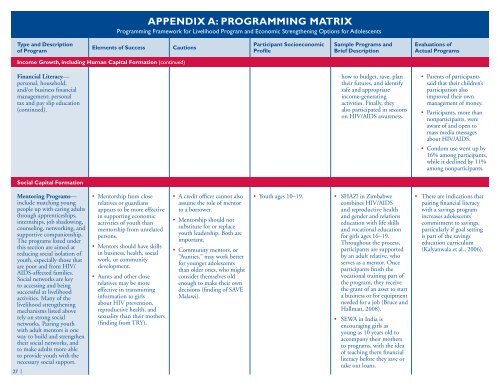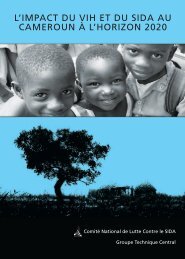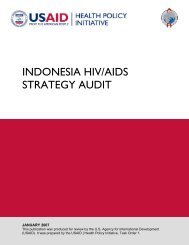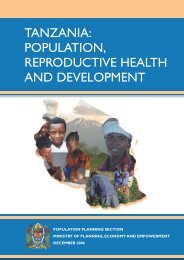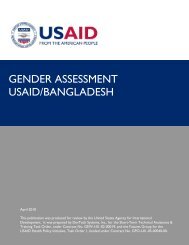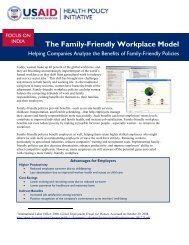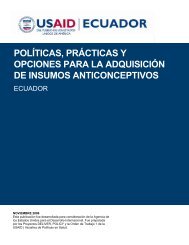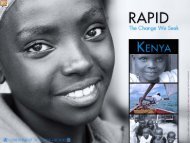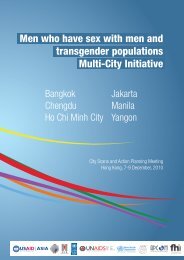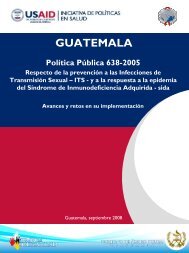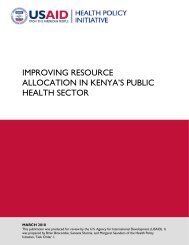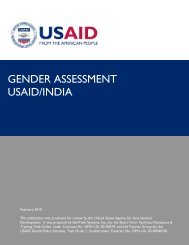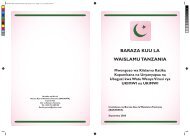LIVELIHOOD OPTIONS FOR GIRLS: - Health Policy Initiative
LIVELIHOOD OPTIONS FOR GIRLS: - Health Policy Initiative
LIVELIHOOD OPTIONS FOR GIRLS: - Health Policy Initiative
- No tags were found...
You also want an ePaper? Increase the reach of your titles
YUMPU automatically turns print PDFs into web optimized ePapers that Google loves.
APPENDIX A: PROGRAMMING MATRIXProgramming Framework for Livelihood Program and Economic Strengthening Options for Adolescents 1Type and Descriptionof ProgramElements of SuccessCautionsParticipant SocioeconomicProfile2Sample Programs and3Brief DescriptionEvaluations ofActual ProgramsIncome Growth, including Human Capital Formation (continued)Financial Literacy—personal, household,and/or business financialmanagement; personaltax and pay slip education(continued).Social Capital Formationhow to budget, save, plantheir futures, and identifysafe and appropriateincome-generatingactivities. Finally, theyalso participated in sessionson HIV/AIDS awareness.• Parents of participantssaid that their children’sparticipation alsoimproved their ownmanagement of money.• Participants, more thannonparticipants, wereaware of and open tomass media messagesabout HIV/AIDS.• Condom use went up by16% among participants,while it declined by 11%among nonparticipants.Mentoring Programs—include matching youngpeople up with caring adultsthrough apprenticeships,internships, job shadowing,counseling, networking, andsupportive companionship.The programs listed underthis section are aimed atreducing social isolation ofyouth, especially those thatare poor and from HIV/AIDS-affected families.Social networks are keyto accessing and beingsuccessful at livelihoodactivities. Many of thelivelihood strengtheningmechanisms listed aboverely on strong socialnetworks. Pairing youthwith adult mentors is oneway to build and strengthentheir social networks, andto make adults more ableto provide youth with thenecessary social support.27 |• Mentorship from closerelatives or guardiansappears to be more effectivein supporting economicactivities of youth thanmentorship from unrelatedpersons.• Mentors should have skillsin business, health, socialwork, or communitydevelopment.• Aunts and other closerelatives may be moreeffective in transmittinginformation to girlsabout HIV prevention,reproductive health, andsexuality than their mothers(finding from TRY).• A credit officer cannot alsoassume the role of mentorto a borrower.• Mentorship should notsubstitute for or replaceyouth leadership. Both areimportant.• Community mentors, or“Aunties,” may work betterfor younger adolescentsthan older ones, who mightconsider themselves oldenough to make their owndecisions (finding of SAVEMalawi).• Youth ages 10–19.• SHAZ! in Zimbabwecombines HIV/AIDSand reproductive healthand gender and relationseducation with life skillsand vocational educationfor girls ages 16–19.Throughout the process,participants are supportedby an adult relative, whoserves as a mentor. Onceparticipants finish thevocational training part ofthe program, they receivethe grant of an asset to starta business or for equipmentneeded for a job (Bruce andHallman, 2008).• SEWA in India isencouraging girls asyoung as 10 years old toaccompany their mothersto programs, with the ideaof teaching them financialliteracy before they save ortake out loans.• There are indications thatpairing financial literacywith a savings programincreases adolescents’commitment to savings,particularly if goal settingis part of the savingseducation curriculum(Kalyanwala et al., 2006).


